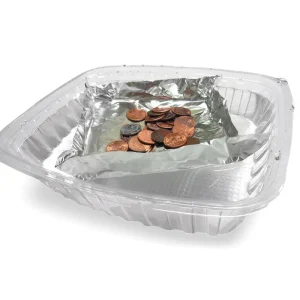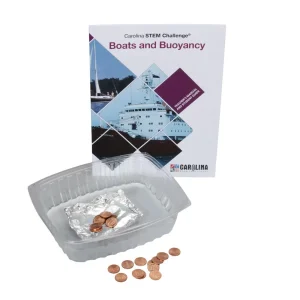Using a 6″ x 6″ square of aluminum foil, students design a boat that supports as many pennies as possible while remaining
afloat. This simple yet challenging activity invokes critical thinking and problem solving while reinforcing engineering, buoyancy, and density principles.
Materials Required (per station)
- Aluminum Foil Square, 6″ x 6″
- Pennies
- Plastic Container, 1 gal
- Water
Activity Procedure
- Fold 1 aluminum foil square into desired boat shape.
- Place the boat in the plastic testing container filled with water.
- Place 1 penny in the boat. After a few seconds, observe how the penny affects the boat’s buoyancy.
- Continue adding pennies, 1 at a time, until the boat begins to take on water or sinks.
- Remove the boat from the testing container and count the pennies in the boat. In the table below, record the number of pennies the boat held before taking on water. Do not count the penny that caused the boat to sink.
- Make any adjustments to the shape of your foil boat that you think might increase the number of pennies it can hold before sinking. Consider the initial design of your boat and the number of pennies that it held.
- Repeat steps 1 through 6 two more times, making any adjustments to the boat’s shape between trials, and record in the table the number of pennies held by the boat each time.
| Trial | Number of Pennies Held |
|---|---|
| 1 | |
| 2 | |
| 3 |
Results/Summary
Buoyancy describes the tendency or ability of an object to rise or remain at the surface of a liquid in which it is immersed. Buoyant force is the applied force in an upward direction against the immersed object. The volume of fluid displaced is directly proportional to the weight of the fluid. The more fluid displaced, the greater the weight displaced. If the weight of the fluid displaced is less than the object, the object will sink.
Density is a physical property based on the relationship between an object’s mass and its volume (density = mass â„ volume). If an object is less dense than the fluid or gas it is in, the object will float. If the object is denser than the fluid or gas it is in, the object will sink.
Extension Activity
For more accurate results, use pennies dated before or after 1982, but not minted in 1982. During that year,
the metal content changed, affecting the coin’s density. Challenge your students to learn more about pre- and post-1982 pennies and incorporate what they learn.
Carolina STEM Challenge®: Boats and Buoyancy Kit
“Anchors aweigh” as design teams work to build a better boat starting with the classic aluminum foil model. Discover whether shape, size, or material (foil, clay, or wood) is the key to success for supporting maximum load. This simple yet challenging lab activity invokes critical thinking and problem solving while reinforcing engineering, buoyancy, and density principles.






